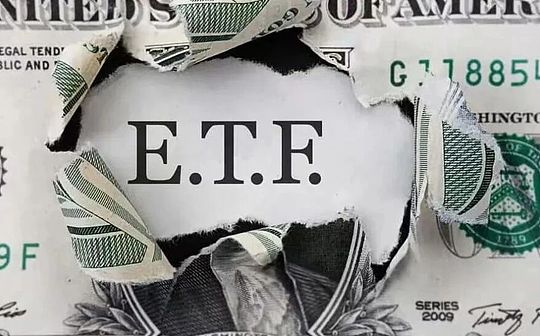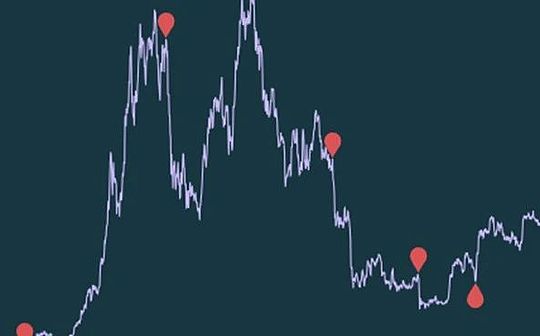
Original author: Shane Neagle, CoinGecko, Original source: coingecko
How does Bitcoin price perform after each halving?
After each halving, the price of Bitcoin rose by 3230% in an average of one year.However, considering Bitcoin’s novelty in its early stages, its lack of market maturity, and its diminishing returns.
How exactly did Bitcoin price perform in the first three halvings before further researching the diminishing returns of the halving?
When the Bitcoin mainnet went online on January 3, 2009, the block reward was a generous 50 BTC.
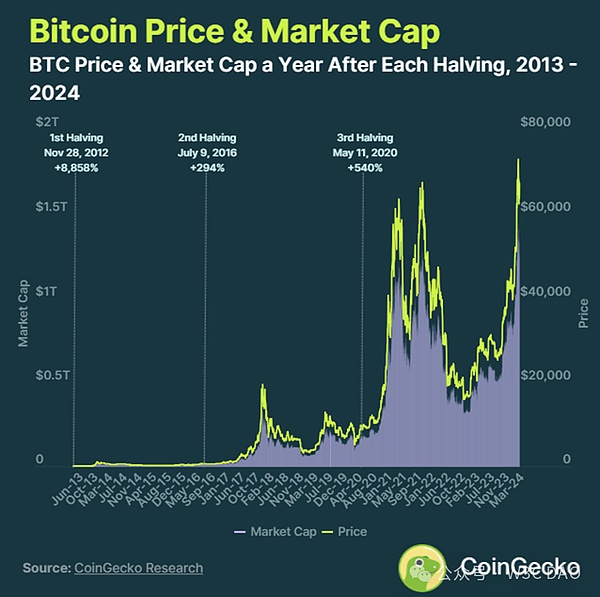
The first halving:On November 28, 2012, it dropped from 50 BTC to 25 BTC.Within 12 months (as of November 28, 2013), the price of BTC rose from approximately $12 to $1,075, resulting in an 8,858% increase in valuation.By January 2022, Bitcoin’s inflation rate rose from 25.75% to 12%.
The second half:On July 9, 2016, it dropped from 25 BTC to 12.5 BTC.In 12 months (as of July 9, 2017), the price of Bitcoin rose from about $650 to $2,560, causing a valuation to rise by 294%.By August 2016, Bitcoin’s inflation rate rose from 8.7% to 4.1%.
The third halving:On May 11, 2020, it dropped from 12.5 BTC to 6.25 BTC.In 12 months (as of May 11, 2021), the price of BTC rose from about $8,727 to $55,847, causing a 540% increase in valuation.By June 2020, Bitcoin’s inflation rate rose from 3.7% to 1.8%.
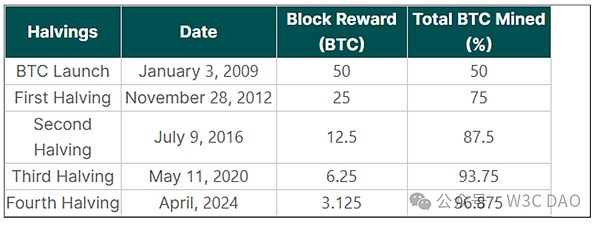
Judging from this model, it is obvious that Bitcoin halving often brings decreasing returns.
Although the gains after the third halving are greater than the gains after the second halving, the increase in the Fed’s money supply casts a shadow on this point.By increasing the M2 money supply, the Fed effectively repriced Bitcoin.
This became obvious after the Federal Reserve began to curb asset prices and reverse the trend through a new round of interest rate hikes in March 2022.
Before and after the Bitcoin market value is halved
The week before Bitcoin’s first halving on November 28, 2012, Bitcoin’s market capitalization was only $123.3 million.The day after the halving, it rose to $130.3 million.Within three months, by the end of February 2013, Bitcoin’s market value reached US$335.2 million.Just one month later, Bitcoin approached the $1 billion milestone with a market value of $947.4 million.
The second halving on July 9, 2016 is a different scene.Bitcoin’s market cap rose to its annual high of $11.9 billion a month ago due to expectations of halving.A week ago, Bitcoin’s market capitalization was $10.2 billion.Three months later, the market value actually fell to $9.6 billion.After the market adjustment, Bitcoin did not reach an all-time high of $16.4 billion until January 2017.
Finally, Bitcoin’s third halving in May 2020 began at $182.5 billion.Within three months, Bitcoin’s market value increased to $217.3 billion.
Market events and maturity play a greater role than halving, although they are jump points.In August 2016, Bitfinex was hacked, offsetting the three-month increase.However, this is just delaying the new ATH market cap until January 2017.
Why is Bitcoin halving important?
In fact, Bitcoin halving is a mechanism to curb inflation.Unlike fiat currencies, according to the actions of the central bank, the inflation rate of fiat currencies is unpredictable, Bitcoin’s inflation rate is predictable, unchangeable, and drops with each halving.
During the halving event every four years, miners’ rewards for protecting and handling Bitcoin transactions are halved.As the supply inflow of new bitcoins decreases, the price of existing bitcoins becomes more attractive.
Bitcoin halving yield diminishes
Since the supply of Bitcoin is limited, at about 21 million bitcoins, new inflows to Bitcoin will slow down.As more and more bitcoins enter the circulation supply, the market becomes more saturated and Bitcoin pricing is more efficient.
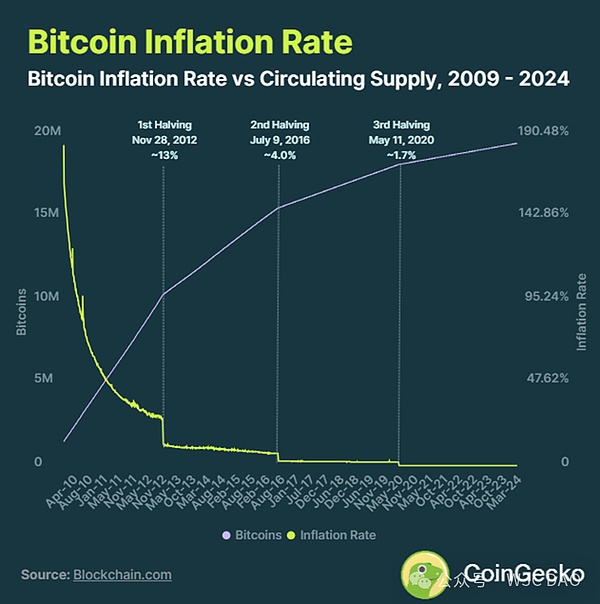
At present, 93.3% of Bitcoin has been mined, that is, 19.6 million of Bitcoins out of 21 million Bitcoins, with an inflation rate of about 1.74%.
This means that if demand exceeds the current 1.74% inflation rate, the price of Bitcoin will rise.In turn, around April 20, 2024, Bitcoin’s fourth halving demand only required more than 1% inflation.
Market trends after halving
Bitcoin halving is just the baseline of Bitcoin price prediction after halving.Given that Bitcoin’s inflation rate will drop below 1% after the fourth halving, demand will be easier to surpass it.
However, there are several factors to be achieved:
The pressure of selling
Bitcoin perception
Global market liquidity
Cryptocurrency regulation
Macroeconomic conditions
Crypto Market Events
All of these factors played a role after the third halving between 2020 and 2024.Some are more than others.For example, when Elon Musk tweeted that “you can buy a Tesla with Bitcoin now,” Bitcoin reached a price of nearly $65,000 a month later.

Similarly, when Musk portrayed Bitcoin as not environmentally friendly enough, the price of Bitcoin plummeted.In addition, the collapse of multiple centralized cryptocurrency exchanges throughout 2022 will only amplify tightening of market liquidity and the Fed’s interest rate hike cycle.
Dynamics between regulatory uncertainty, rising interest rates, cryptocurrency collapse and inflation have triggered a capital outflow in Bitcoin.As these FUD supplies eventually run out, Bitcoin rose again after the U.S. regional banking crisis.
Without these baggage, the Bitcoin market is more mature than ever.We can use the market value of Bitcoin to represent this level of maturity.
Selling pressure before and after Bitcoin halving
Bitcoin performed strongly at the beginning of the year before Bitcoin’s fourth halving in April 2024.Since then, Bitcoin has broken through the all-time high of $69,044.77 set in 2021, hitting a new high of $73,737.94.
This is due to a surge in optimism about crypto assets.Among them, the successful launch of approved Bitcoin ETFs is particularly prominent.This milestone helps take Bitcoin’s legitimacy to a new level and contribute to the positive sentiment in the market.
Retail investors and institutional investors can now participate in Bitcoin price exposure through stocks without directly custodying Bitcoin.As of March 25, the nine approved Bitcoin ETFs have accumulated more than 4.736 million Bitcoins, while Grayscale’s Bitcoin outflow is 2.694 million.The US spot Bitcoin ETF holds a total of 8.239 million Bitcoins, accounting for 4.2% of the total Bitcoin mining volume.
While Bitcoin ETFs have been inflows since their inception, it is uncertain whether they can keep up with the selling pressures of Grayscale due to the lack of competitiveness of fees.Most importantly, as hashrate and difficulty increase, Bitcoin miners may be profitable, as mining costs are expected to increase.
While analysts predict bullish results for Bitcoin prices after halving, this forecast could be frustrated or delayed as another selling pressure comes from Mt. Gox’s allocation of 200,000 BTC (approximately $13.9 billion)plan to repay creditors.
Before these downsides, Bitcoin price will encounter two hype events:
The fourth halving will be achieved in April 2024
The Fed cuts interest rates for the first time, expected in May or June 2024
Overall, Bitcoin’s market positioning has never been as stable as it is now.Bitcoin ETFs will bring a new generation of investors and a new marketing offensive.Meanwhile, fiat currencies will continue to depreciate wildly under a debt-based monetary system.
This makes Bitcoin a unique choice for investors because its supply is pre-determined and has nothing to do with demand.With Bitcoin inflation below 1%, the lowering of demand thresholds may exceed future selling pressures.




